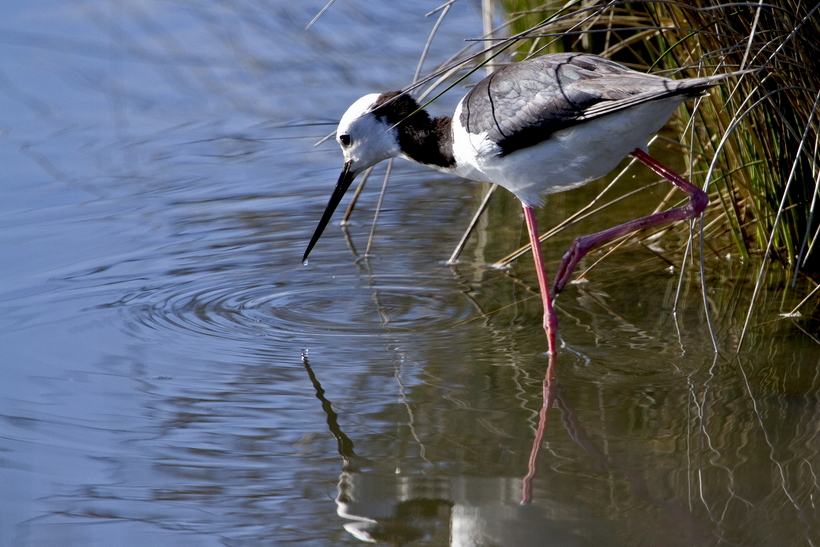Birds of the Inlet
Fifty species of birds regularly occur in the Pāuatahanui Inlet and its immediate terrestrial margin. Twenty-nine species are associated directly with the Inlet waters, fringing marshes and streams and 21 with the terrestrial margin. Fourteen ‘resident’ species are always present on or about the water and 12 on the terrestrial fringe. Most of the remainder are seasonal migrants from within New Zealand that come every year, usually in their non-breeding season. There are also visitors such as the two or three Gannets that appear for a few days each year. The Eastern Bar-tailed Godwit is a spectacular migrant that breeds in north-eastern Siberia and migrates south every northern winter; a few of these come to the Inlet.
The most commonly seen birds on the Inlet and in its marshes are Southern Black-backed Gull, Red-billed Gull, Mallard, Paradise Shellduck, Black Swan, Royal Spoonbill, Pied Stilt, Spur-winged Plover, Oystercatcher, Little shag, Black Shag, White-faced Heron and Pukeko.

For descriptions of some of the birds present around the Inlet select the name of interest.
Trends in the occurrence of birds found in and around the Inlet are monitored by the Ornithological Society of New Zealand every 10 years. The most recent review of these trends (August 2023) has been provided by Ian Armitage of the Society and is available to read.
Habitats and the birds they support
One feature of the Inlet that is unusual in the Wellington region is that it includes many different habitats within a small area.
Tidal flats and sand banks.
When the tide is out spoonbills, oystercatchers, gulls, pied stilts, herons, plovers, etc., feed on the cockles, snails, worms and small crabs they find here. When the tide is in, diving birds such as ducks and black swans eat the seagrass and algae.
Saltmarsh and nearby pasture.
These are the feeding grounds of grazing birds and those that eat worms, snails, insects and insect larvae. Such birds are geese, pukeko, paradise shellducks, mallards, kingfishers and swallows.
Open water.
Fishing birds such as shags, gulls and the occasional visiting gannets find good hunting here.
Streams.
Weeds, insect larvae on the bottom and adult insects flying above the water provide food for ducks, kingfishers, pied stilts, swallows etc.
Woodland and domestic gardens.
Birds such as starlings, blackbirds, tui, fantails, grey warblers, waxeyes, finches, sparrows, swallows and pigeons find insects, insect larvae, worms, snails, pollen and nectar in these environments.
Bird Activity
Bird activity provides for some spectacular sights.
- Royal Spoonbills feed elegantly by sweeping their long bills from side to side in shallow water. Their numbers seem to be increasing each year as the breeding colony on Kapiti Island expands. Sometimes a flock of them can be seen flying home to Kapiti in the evening.
- Back Swans move majestically around the Inlet like an armada of tall ships.
- Shags in mobs cruise the Inlet just above the water, suddenly settling and fishing.
- Herons sedately parade close to the shore, stepping carefully as they hunt for small flounders.
- Starlings wheel and turn in great squadrons in an aerobatic display, before they roost at sundown in winter.
- Gulls rise and swoop with the thermals and air currents on sunny and windy days.
The problem with some birds.

The birds of the Inlet are a delight to see and usually add to the enjoyment of a visit to the area. But not every species has a positive effect on the environment that it inhabits. Both black swans and Canada geese are a cause for concern.
Dense seagrass beds provide an excellent habitat for many small invertebrates that are part of the food chain for fish and birds, while these beds may also help to protect cockles. But seagrass is also the favourite food of the black swan and if its population grows significantly the seagrass plant and animal communities are put under pressure. Seagrass meadows are already in decline in the Inlet and any increase in the numbers of swan may well cause further losses to the current areas of colonisation. This is where we would like to see more research being done.

However, of even greater worry are the numbers of Canada geese, a bird that arouses mixed feelings. While these are impressive and attractive birds, they are an introduced species and have reached pest proportions in some countries. Canada geese can be aggressive to humans, particularly during their breeding season, but the biggest problem is the competition they create for the naturally occurring native birds that use the Wildlife Reserve to raise their young. Interference with native birds, for which the Reserve exists, pushes them out of their habitats and causes losses to the eggs and young.
Also it is a voracious feeder, each bird producing copious quantities of bird dropping which is rich in nitrogen and a potent eutrophication agent in the confines of the shallow saltmarsh ponds.
Numbers of the geese have declined recently since Transmission Gully development took over one of their roosting sites at Lanes Flat but they are still around and the population will need to be monitored on an ongoing basis.